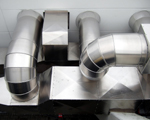Being a noise engineer, I’m always on the “listen-out” for cases of poor building acoustics. I find that common offenders are noisy air handling (HVAC) systems. Frequently the public venues are restaurants, hotels and cinemas, and on occasion it’s a location most tragic, a performance space.
HVAC noise in a performance space distracts listeners and hinders performers. Dramatic pauses are spoiled. Voice and music are more difficult to hear. Bad news for everyone.
Exposing audiences and performers to the HVAC noise is avoidable if the original design incorporates noise control measures from the start of the project. Mechanical engineers should select quiet equipment, incorporate duct treatments, reduce airflow generated noise, and specify adequate vibration isolation for low noise systems. Architects also have a role in locating equipment to minimize impact.
Some of the most unfortunate situations I encounter in the field are noisy rooftop air handlers that are directly above acoustically sensitive spaces. The installations often violate most or all of the noise guidelines just named. The fixes frequently get quite expensive, so the best practice is to avoid them in the first place. If the equipment MUST be located near acoustically sensitive spaces, design adequate noise controls from day one of the project and make sure they are not eliminated from the project in a value engineering phase. Architects, mechanical engineers and noise control engineers need to work together to make this happen.
